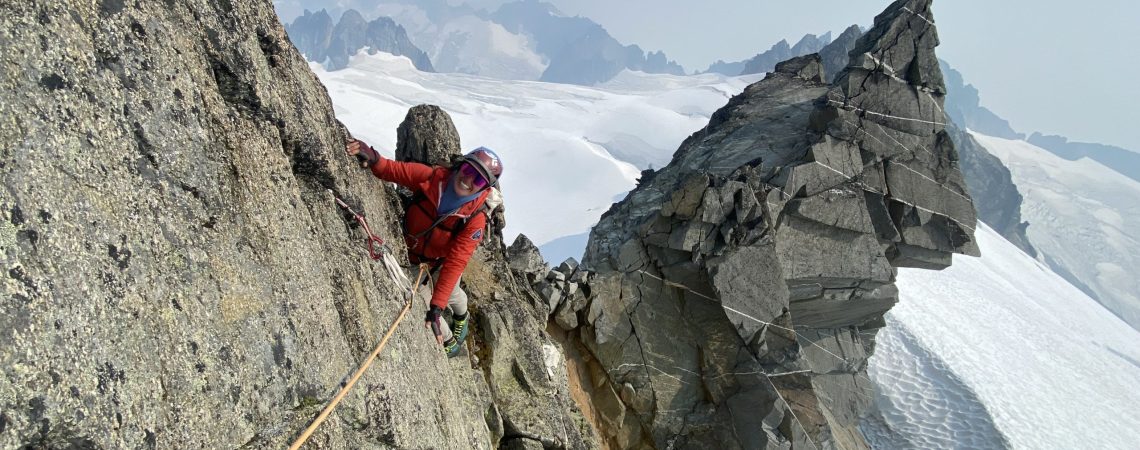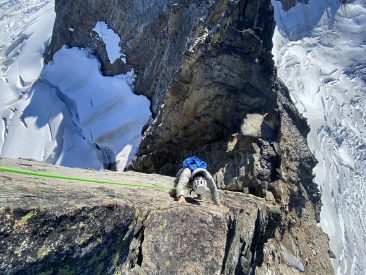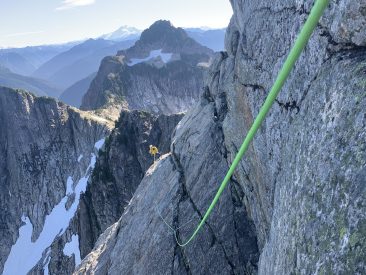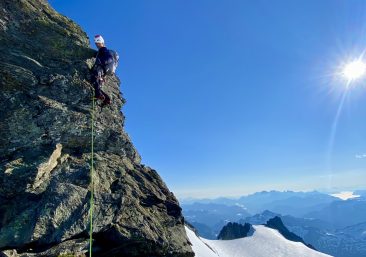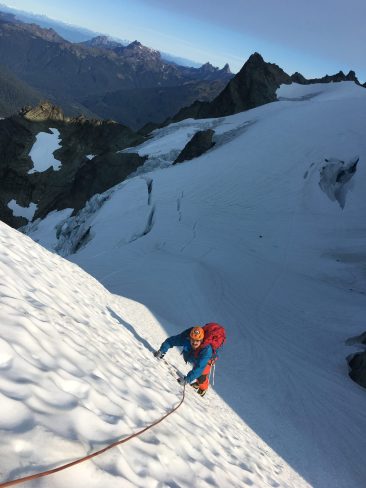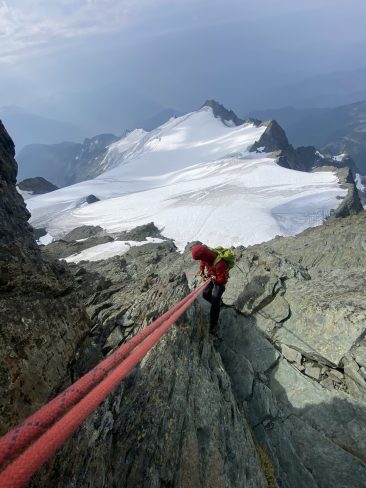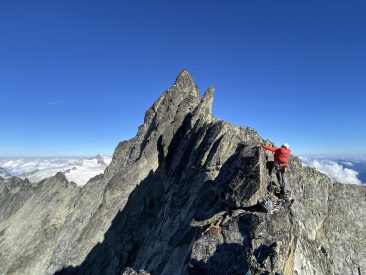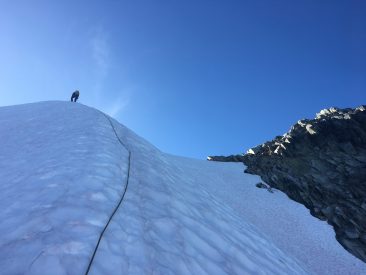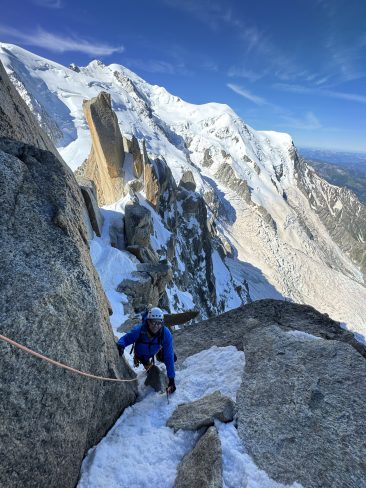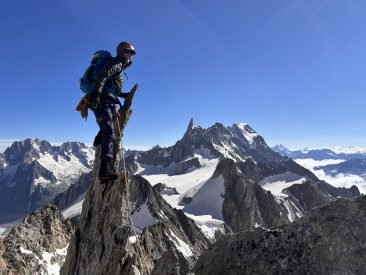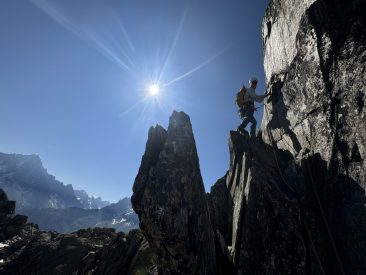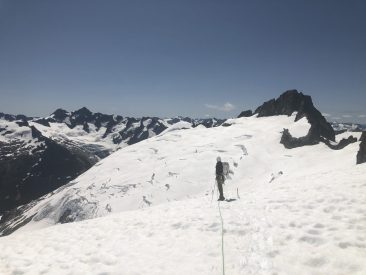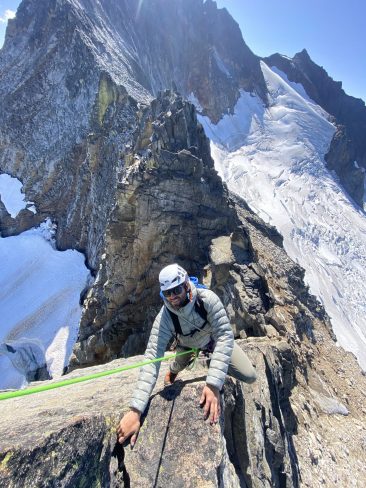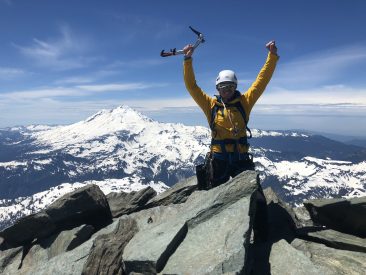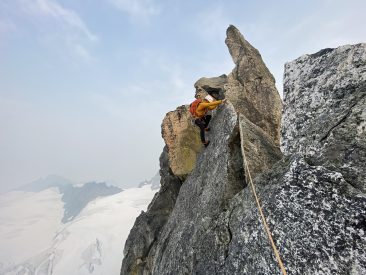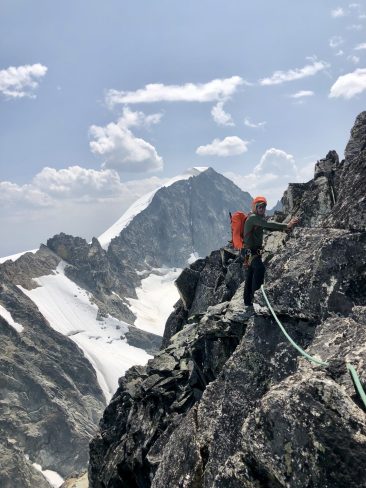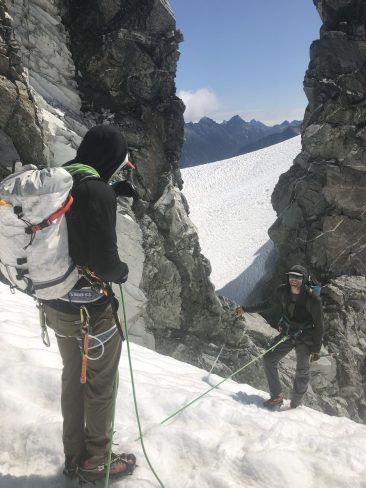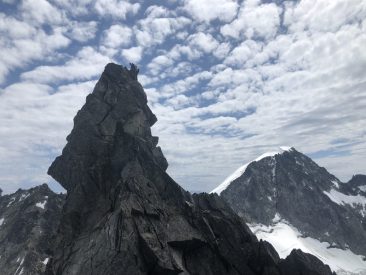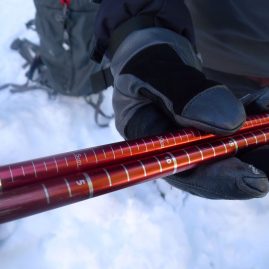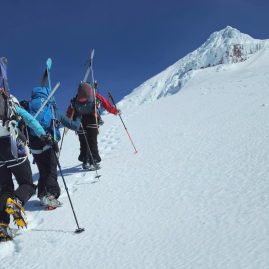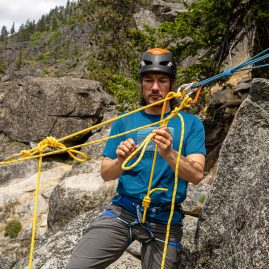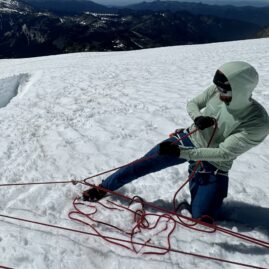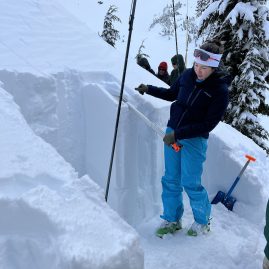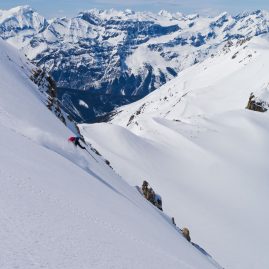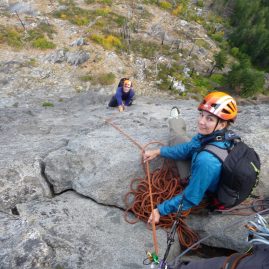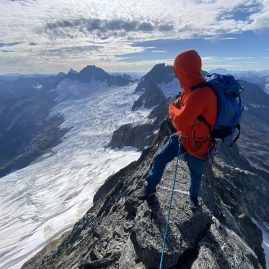- Dates: July 25-29; August 8-13, Sept 5-9
- Duration: 5 days
- Level: Intermediate to Advanced
- Client Ratio: 2:1
- Cost:– 2:1 $1050 or 1:1 $2000
- Included:Park fees, group climbing equipment, and guide services. *(meals while on the mountain, tents, stoves, cook kits and personal climbing equipment rentals available)
- Not Included:Ground transportation airfare, transportation within Seattle, hotel accommodations, restaurant meals, gratuities for guides, all meals while on the mountain, tents, stoves, cook kits, and all personal items.
Our Intermediate Alpine Climbing Course is designed for climbers who already have basic glacier and mountaineering experience and are ready to take their skills to the next level. This multi-day program focuses on more advanced alpine movement, technical rope systems, and efficient transitions in complex terrain. You’ll refine your route finding, anchor building, and belay techniques while learning to manage risk and make sound decisions in the mountains.
Through a combination of instruction, guided climbing, and real-world problem solving, you’ll gain the confidence to lead or co-lead moderate alpine routes. The course is ideal preparation for longer, more technical climbs in the Cascades and beyond. With personalized coaching and plenty of time on the sharp end, participants will leave with the knowledge, efficiency, and judgment to move safely and effectively through more challenging alpine terrain.
What you will learn
- Advanced alpine movement on rock, snow, and mixed terrain
- Efficient rope management and transitions between pitches and terrain types
- Building and evaluating rock, snow, and mixed anchors
- Multi-pitch belay techniques and stance organization
- Short-roping and short-pitching for complex alpine travel
- Protecting traverses, ridgelines, and steep snow sections
- Route finding and hazard assessment in variable alpine conditions
- Time management, pacing, and decision-making on longer climbs
- Strategies for leading or co-leading moderate alpine routes
Climbing Gear
- Climbing Helmet: Lightweight
- Rock Climbing Harness: Padded and adjustable
- Approach Shoes(After July 4th or when the now is gone)
- Rock Climbing Shoes – Snug and comfortable
- Belay Device: Autoblocking style belay device (example Petzl Reverso)
- Nylon Slings: (1) 60 cm nylon sling, (1) 120 cm nylon sling
- 2 Locking carabiners 2-Large, pear-shaped carabiners;
- 2 Regular carabiners (e.g. Wire-gate are recommended)
Early Season
- Ice Axe Lightweight Under 5’7” use 60cm, 5’7”- 6’2” use 65cm,
- 3 Season mountaineering boots (Must be crampon compatible)
- Crampons with anti-ball plate,
- Adjustable trekking poles- optional
Upper Body
- Synthetic T-shirt
- Sun Hoodie Lightweight, light colored for sunny days
- Sports bra Two, synthetic,
- Soft Shell with hood
- Mid-Weight Down/Synthetic Jacket (with hood)
- Hard shell jacket with hood Waterproof and breathable. Gore-Tex or equivalent is best
- 1 Pair light leather palmed gloves for warmth and rappelling
- Warm hat Wool or synthetic
- Buff or Balaclava
- Shade hat or baseball cap
Lower Body
- 1 Pair soft shell pants lightweight
- Synthetic hiking socks
Backpack
- 50-60 litter pack. Optional 20-30 “on route” pack.
Miscellaneous Equipment
- Sunglasses 100% UV protection with side shields or wrap around.
- Personal first aid repair kit Basics: moleskin/blister kit, Band-Aids, first-aid tape, ibuprofen, personal medications, and batteries etc.
- Lip balm At least SPF 20
- Sunscreen At least SPF 40
- Headlamp lightweight LED
- 2 water bottles 1 liter wide-mouth Nalgene and 1 bottle holster, or
- Hydration bladder With drinking tube and 1 Nalgene bottle
- WAG Bag or toilet paper stored in a plastic bag.
- Bandana
- Hand wipes
- Favorite snack food
Day 1 – Hike In and Skills Refresh
Meet your guides, review course goals, and conduct a gear check before hiking into a high-alpine basecamp. Once established, review essential knots, belay transitions, and anchor systems. Finish the day with a field session on rope handling and efficient movement in alpine terrain.
Day 2 – Crevasse Rescue and Snow Belay Refresher
Begin the day reviewing glacier travel systems, rope spacing, and hazard recognition. Spend the remainder of the day refining crevasse rescue techniques, including hauling systems, self-rescue, and team rescue scenarios. Wrap up with a refresher on snow belays, snow anchors, and running protection in steep snow terrain.
Day 3 – Technical Rock and Route Systems
Focus on multi-pitch efficiency, stance management, and belay transitions on technical rock terrain. Practice building natural anchors, managing rope drag, and protecting traverses or mixed sections. End the day with scenario-based exercises to integrate skills across multiple terrain types.
Day 4 – Alpine Summit Objective
Apply your skills on a classic alpine climb. Students take an active role in route finding, transitions, and leading or co-leading sections under guide supervision. Emphasis is placed on efficiency, communication, and sound decision-making in real-time alpine conditions.
Day 5 – Exit and Debrief
Pack up camp and hike out. Conclude the course with a comprehensive debrief, individualized feedback, and discussion of next steps in your alpine progression.
WHO WILL MY GUIDE (OR GUIDES) BE?
We are small company who enjoy working together in the mountains as well as highly skilled professionals who hold current Wilderness First Responder certification and are proficient in technical rescue and evacuation skills. Our guides are dedicated to the world of alpinism, many having first ascents and hold professional certifications with the AMGA in the rock, alpine, and ski disciplines. The AMGA is part of the IFMGA, which is the international body of certified mountain guides.
HOW MUCH SHOULD I TIP MY GUIDES?
Tipping is considered standard practice in the guiding industry. Tipping amounts vary – so $20-30 per day per person/per guide is average that works well for the guides without a serious blow to your wallet. Often 10% of the course cost is a good rule-of-thumb. If you feel that the program was exceptional or substandard the tip can reflect that.
CAN I RENT EQUIPMENT FROM BCAG?
No, for these trips we strongly suggest to buy your equipment due to obscenely large rental costs for trip of this length.
HOW HEAVY WILL MY PACK BE?
Day trips will keep your pack between 10-15 pounds max.
WHEN DO I NEED TO PAY THE BALANCE OF MY TRIP?
For Scheduled Domestic Courses and Climbs: Your balance is due 60 days from trip departure. Payable by check, Credit Card with service charge or Venmo.
WHAT HAPPENS IF I NEED TO CANCEL MY TRIP?
If you should decide to cancel your trip, BCAG must be notified in writing. Your trip will be cancelled from the date we receive written notice. You will be assessed a cancellation fee according to the following schedule:
90 to 31 days from trip departure – 50% of trip cost
30 days or less – 100% of trip cost
WHAT HAPPENS IF BC ADVENTURE GUIDES HAS TO CANCEL MY TRIP?
In the rare circumstance where we need to cancel a program you can reschedule without a fee or receive a refund on your deposit. If circumstances arise that force us to cancel a program that is already in progress, we reserve the right to decide whether a refund or credit, at a prorated rate, will be issued. We are not responsible for cancellation fees or costs arising from your changed or cancelled flights, lodging, or other arrangements. We strongly recommend obtaining trip cancellation insurance from your travel agent.


